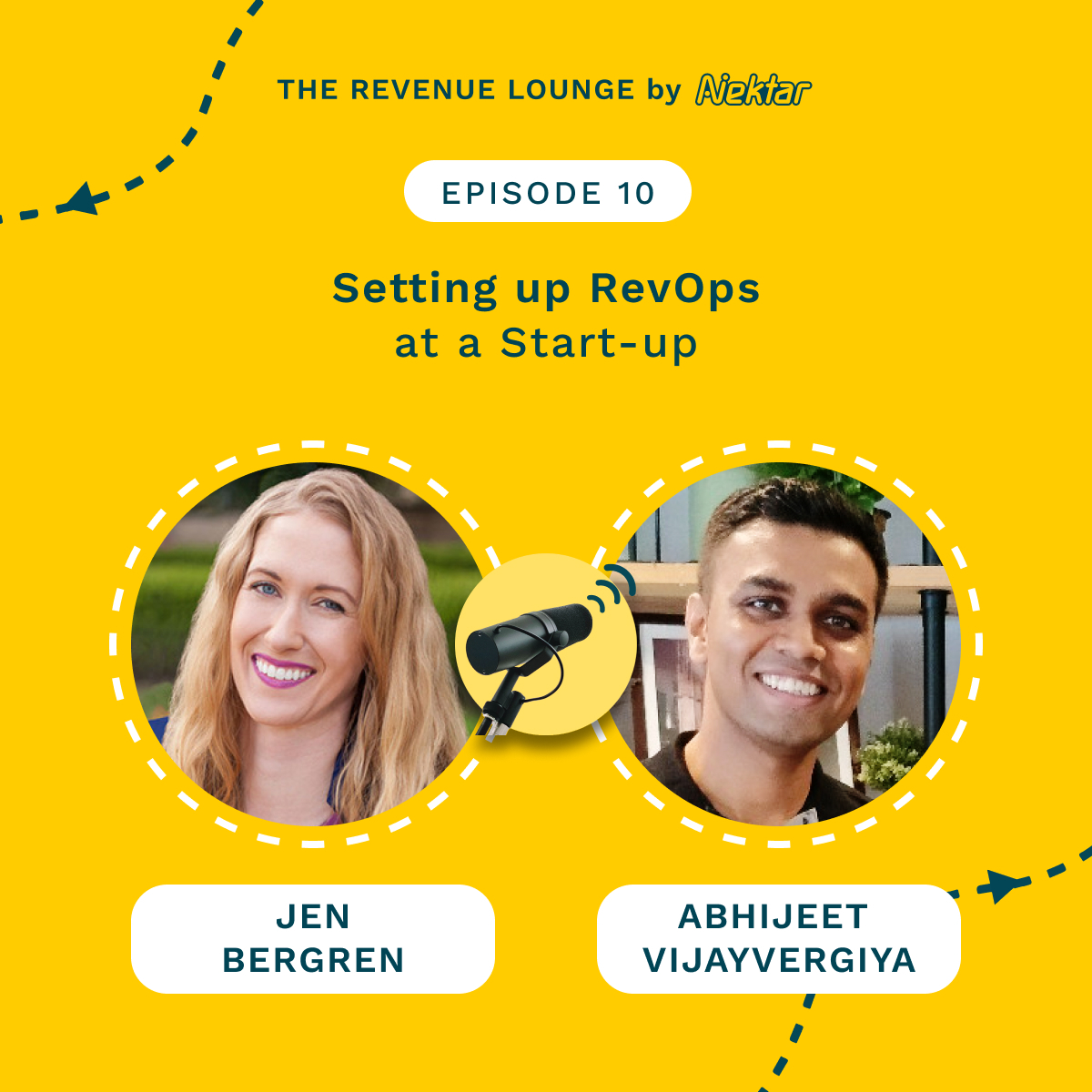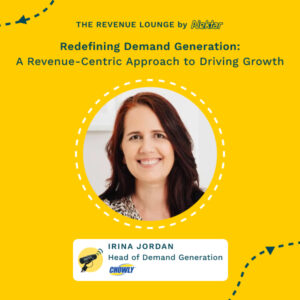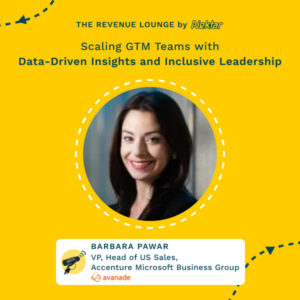RevOps Reporting: From Strategy to Execution ft. Tyler Will
October 30, 2024
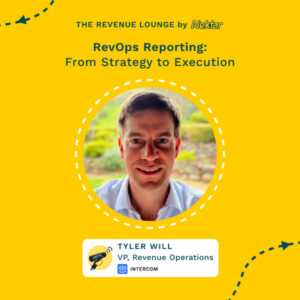
About
The Revenue Lounge
The podcast covers stories from leaders across RevOps, Sales, Customer Success, GTM, Data and Marketing about what drives these functions and what advice they would share with our listeners. With 3 seasons recorded, the podcast currently features 50+ enterprise leaders in the B2B SaaS domain. Tune in to hear from the best in the business
In this episode of the RevOps Lounge podcast, host Randy Likas interviews Tyler Will, VP of Revenue Operations at Intercom. They discuss how RevOps teams can evolve their reporting to provide actionable insights that drive business strategy and fuel growth.
Key Discussion Points:
- Common challenges for RevOps teams in turning data into insights (00:00:33)
- Steps for incorporating reporting and insights into strategic initiatives from the start (00:03:10)
- Translating data into narratives and actionable insights (00:07:15)
- Measuring the business impact of RevOps insights (00:26:50)
- Using data and insights proactively instead of just reactively (00:33:24)
- The role of AI in extracting insights from data (00:39:15)
Guest Bio:
Tyler Will is the VP of Revenue Operations at Intercom. He previously led the global SMB sales strategy and operations team for LinkedIn Talent Solutions.
Company Bio:
Intercom is a customer communication platform for sales, marketing, and support teams. The San Francisco-based SaaS company was founded in 2011.
Key Quotes:
“Any strategic planning needs from the beginning include that idea of reporting and execution monitoring and all of that.” (00:03:10)
“It becomes an insight when it’s data or some feedback or, you know, qualitative insights certainly are are just as valuable that’s presented in a context or in a positioning that isn’t the way we’ve necessarily considered it before.” (00:16:37)
“If I could waive it for Intercom as Will the consumer plus us of getting the right understanding of of AI and how it’s gonna work and the ROI and why it’s valuable from from both sides, I think that’s the place that everybody’s still stumbling through.” (00:43:55)

Randy Likas (00:02.4)
Data is everywhere, but the challenge lies in turning that data into actionable insights. For revenue operations teams, reporting isn’t just about tracking what’s already happened. It’s about using the data to drive strategic decisions, enhance performance, and fuel future growth. But how do you make the leap from simple data collection to meaningful forward-looking insights that align with broader business goals? And how can rev ops reporting evolve to not only reflect past performance, but also provide a clear roadmap for the future?
Hello everyone, welcome to the Revenue Lounge Podcast. I am your host, Randy Likas, and in today’s episode, we will explore the journey from strategic planning to the execution of rev ops reporting. We’ll dive into the common challenges teams face, the key steps to turning data into action, and the different phases of maturity in rev ops reporting. Joining me today is Tyler Will. Tyler is the Vice President of operations, of revenue operations at Intercom, prior to Intercom.
Tyler led the global SMB sales strategy and operations team for LinkedIn talent solutions. Tyler, thanks so much for joining us today.
Tyler Will (01:05.55)
Thanks for having me, Randy. Good to be here.
Randy Likas (01:07.904)
Great. Tyler, I’d like to start and just learn a little bit about you. So maybe you can talk a little bit about your background and your current role at Intercom today.
Tyler Will (01:20.748)
Yeah, absolutely. So my inner intercom role is about a year and a half in now. I started out leading the sales operations team and now revenue ops when we brought the marketing ops team in about nine months ago. And I lead about 30 people across a range of functional areas. So we’ve got a core ops team that’s deal desk and then the day to day kind of sales facing folks doing forecasting and
book carving and all those kind of activities. We have a planning and comp team that’s doing incentive design, setting targets every quarter and working really closely with our finance crew. We have a go-to-market analytics team that does everything from top of funnel all the way through to renewal kind of reporting and analysis, which is big focus for us today. So that’s exciting. We’ve got a strategy team that kind of does big company initiatives and then a systems team that works on our tech stack.
Randy Likas (02:23.424)
We froze there for a moment. This will be one of the pieces that will get edited out will be the freezing here for a moment. It has happened before. If it happens again, finish your answer because it’s usually it’s going to capture and then we’ll edit it out on the back end.
Tyler Will (02:25.358)
think we froze too deep.
Tyler Will (02:30.03)
I
Tyler Will (02:35.885)
Yeah.
Okay, okay, great.
Randy Likas (02:42.326)
So Tyler, I do a lot of these conversations and I talk with lot of rev ops leaders like yourself. And I think the challenge that many have is rev ops leaders want to have a seat at the strategic table. But you’re also on the hook for delivering the insights back to the business. And I think it goes beyond reporting. would also be about just delivering key value.
I guess, what’s your perspective and what are the sort of key steps involved that you do to stay strategic with your cross-functional teams?
Tyler Will (03:20.16)
Yeah, there, you know, think there are a few different things we do and, you know, one of the keys is, sort of demanding that that seat at the table and having the right, confidence to just sort of say you deserve to be there. But I think one thing we’ve found to be really helpful as we think about kind of tying this into the reporting piece is that any strategic planning needs to, from the beginning, include that idea of, reporting and execution monitoring and all of that. And I think where I’ve seen projects get in trouble is that kind of.
assume we’re going to do all this work and we’re going to flip some switch on whatever day 100 and then we’ll like see what happens after that. And that’s when you get into, you know, the sort of questions of was this investment worthwhile? Was it successful? Did anything work? things went wrong. Like, why did we find out for a while? And so we’ve, I think, done a pretty good job recently at Intercom and
planning for sort of, you know, all the way, all the way to D-Day and then 30 days, know, or a quarter beyond that to try to bring that in. And that, that lets us in RevOps and the reporting function within RevOps be part of that conversation because everybody recognizes the only way you’re going to get all the way through that is having them understand what the business need is, what the problem you’re trying to solve is. So.
We’re really lucky in that we have a great project management team or program management team that helps us sort of think through this, keep us organized and do that. And so one step I’d suggest for people, if you don’t have a formal function is kind of designating somebody in one of these bigger projects is like, you’re going to, you’re going to kind of program. I was sorry, the cat decided to join us really unhelpful timing. I don’t know if you edit that out or not. Yeah. So we have a program management function. Keep that. It makes me human, right?
Randy Likas (04:58.443)
Great.
Tyler Will (04:59.498)
So we bring this program management team in and they keep us organized. What are the best practices? How do we keep all the cross-functional parties sort of deeply involved and deeply aligned? But.
Even if you don’t have that, you can really bring somebody in and just say, hey, 5 % of your job is going to keep us on track, is keeping us on track, keeping everybody coordinated, setting these milestones. And so that’s helped us, I think even on smaller things, just stay focused on the strategy all the way to the execution and the management. So that’s one tip I found to be quite useful.
Randy Likas (05:35.476)
And oftentimes, I think you’re building these dashboards, you’re building these reports, and the data’s there for the leaders to take a look at. I’ve often heard, we build all these great things, but nobody looks at it. And so then what happens is you get all these ad hoc requests, and you’re like, it’s all there. And so what advice might you give for, I guess there’s two parts to the question. One is, do you often find that as well, and how do you manage to that?
Tyler Will (05:44.291)
Yeah.
Tyler Will (05:50.253)
Yep.
Tyler Will (05:55.309)
Yeah.
Tyler Will (06:02.518)
Yeah. So easy question. Yes. I think every, every rep ops team out there has at some point built the requested dashboard, you know, as designed and then looks at that, either the counter in Tableau of how many views it’s gotten or just asked around, you know, like that’s hugely disappointing for what, what we thought this was going to be. I think there are a few things that, that we can do one again, sort of following up. There’s one thing to launch the dashboard. It’s another thing to then sort of support the use and implementation of it.
If you haven’t actually enabled the sales leaders who may not be the most comfortable looking at data and sort of coming up with their own hypothesis and doing their own work, what do you expect them to do? And I think that’s a failing on sort of our part to just say, not only here it is, but here’s how you use it, here’s how you think about it, here’s some questions you might want to ask and try to answer.
There’s probably a cultural element, you you as a sales leader, if you’re sort of like, Hey sales team, what do we know? You sales managers, what do we know? we don’t know anything. Well, I’ll go talk to rep ops. you, know, if you can enforce some accountability there, that certainly helps quite a bit. And then one of the other things I think we found in it, I think it’s a theme that we’re to talk about today is taking that sort of the facts, the report and turning that into actions. And, ultimately insights first. And then ultimately some actions is, you know, setting up the mechanisms, the forums where you actually get.
do that. Again, there’s a little bit of, I think, wishful thinking. If you say, we provided you with all this data, why aren’t you doing something with it? Now, if you say, hey, we provide you with a bunch of data, and the third Tuesday of every month, we sit down and have a conversation about pipeline, and you as a sales leader or me as a rev ops leader are going to ask you a bunch of questions. Well, now there’s pressure to understand it and dig in and use it in a constructive way. And I know what good it’s going to look like at that moment and how it’s going to be used and what I’m expected to know.
Now there’s sort of a reinforcing mechanism for this thing as opposed to here it is, aren’t you happy? Why aren’t you using it?
Randy Likas (07:58.208)
Yeah, so let’s dig into that a little bit more. So I think what I’m hearing you say, and certainly I experienced it myself, is there’s no shortage of data. There’s a ton of data out there. But what’s actionable and how do we help the leaders understand, the cross-functional leaders understand how we translate that data into an insight? And so curious to sort of how you do that today. Like is it?
Tyler Will (08:08.664)
Yeah.
Randy Likas (08:23.542)
You try to turn the data into narratives or stories that align to overall KPIs. What’s that process look like and sort of that cadence look like?
Tyler Will (08:27.362)
Yeah.
Tyler Will (08:31.777)
Yeah. Yeah. I think it’s, it’s, this is very hard. And this is hard even within rev ops, let alone asking other teams who aren’t spending, you know, day in and day out working with data. And so I can maybe talk to it most from the rev op side, but I think there are a couple of ways to sort of think about framing it. And that may help people just turn.
unstructured data a little bit into a narrative. One is from my classic from my consulting days sort of the situation complication resolution, which, basically says, Hey, what’s going on? Why is that interesting in some way? And like, what do we got it? What are we going to go do about it? A shorthand of this is like, what, so what, and what now, which I think can be a little like easy one to kind of remember, like, here are the facts. Here’s why those facts are interesting. Here’s what we, what we do about it. And so this again is a place where
I, and I find I do do somewhat of a poor job of this with my team of like, guys, gotta, you know, you gotta generate more insights and then you walk away. And what you really need to do is actually sit and spend time with people and coach them and show them what good luck like none of us showed up on our first day of work. Knowing what an insight was and an insight is a little, know, it’s a little bit in the eye of the beholder. There’s not a dictionary definition of like once, once it does this, it’s now an insight. And until that point, it’s not. and so
What I, know, when we talk about that sort of that framing a lot, like the what, the so what, the what now, or the situation complication resolution. And I spent 90 minutes just last week. We, do a pipeline report and we’re trying to.
get this and get some traction within it. And it frankly just wasn’t working. It was a lot of just data. And then we’d have a table and then underneath that table would be a bullet point version of that table. And like, just cause you turned it into words, doesn’t, it doesn’t make it an insight. It’s still just, the, you know, the data point from the table.
Tyler Will (10:16.218)
And so we actually broke down. had my go-to-market analytics leader was in the room with me, super sharp guy. And then we had the ICs actually who build this stuff. And we sat down and we’re like, what is good going to look like? Let’s rip this whole thing apart. Let’s rebuild it from the ground up. Because I think that’s the only fair way to hold somebody accountable for something being good is to actually show them what you want them to do. You do the same thing in sales. You wouldn’t be like, go prospect. And then be like, you did a terrible job. You actually have to show them what that looks
like and I too often either we as rev ops leaders we sort of have this I don’t know what it is but I know when I see it or you know sales leaders who were giving this stuff to marketing leaders who were sending things to
We don’t take the time to say, here’s what I really need. Here’s what I want this to be. Here’s how you can make this thing interesting to me, make me want to engage with it and, and set a really clear target. And that may feel like too micromanagey for some people. And I think that’s why we don’t, we tend not to do it. like, I don’t want to micromanage the team. I don’t want to tell them how to do their job. But if you’ve never given them a sense of what their job actually is, how are they supposed to do that and do that successfully? And so it’s something I personally working on, my team is working on is to get out of the vague order.
of go create insights and actions to like let’s actually templatize this. What are we going to show? How are we going to talk about it? How are we going to feed qualitative input into that? And ultimately how do we then be really clear at the end of like our three next steps are thing one, thing two, thing three, and here’s who’s going to go to own them. Now if I’m the IC doing that, you know, a couple years out of school, like it’s not quite paint by number. I still have to think and do it and bring my technical skills to it, but it’s a little bit more of a solvable problem.
And I think we’ve historically, like we as rev ops leaders and sales partners have done a bad job of like doing anything other than demanding more insights and demanding more actions without actually helping the team figure out a way to do that.
Randy Likas (12:10.856)
And I imagine if you’re going to try to deliver an insight, you’ve got to really have an understanding of what’s the problem, right? What’s the problem that we have so that we know what we’re trying to derive this insight towards? And it’s amazing. As you talk, I was making some of the parallels in sales. So many times we’ll talk to somebody and they’ll tell us what a problem is. we’ll say, can you help me understand what’s that impacting? And they’ll say, well, I don’t really have good visibility in terms of what’s going on. Well, is that really? But so what?
Tyler Will (12:18.843)
That’s right.
Randy Likas (12:40.382)
Right? So if you don’t have visibility, like, what’s that preventing you from doing? And it’s sort of getting into that second or third degree need or problem, which is going to, I think, help you actually understand what you’re trying to deliver.
Tyler Will (12:54.11)
Yeah. And I think one of the, the, the flip side, a little bit to this in, at least in rev ops is we often, you know, there’s often one or two people doing this work. And what is asked of them is it is an enormously complex range of things, right? It’s you gotta be technical enough to pull data out of, know, out of your data lake, out of snowflake or whatever. So you’re, writing SQL code, you’re putting it into a Tableau dashboard. You’re
senior enough that you understand what a good deliverable looks like and how to communicate with executives. You’re deep enough into the business so you can actually contextualize whatever it is you’re doing. And then you’re a really good communicator who can put this all together and send it out and have a discussion. That’s a big broad workload. And so how do we make those things easier for people to be successful is really important.
Randy Likas (13:40.39)
You bring up an interesting point, which is, I think, the experience to be able to do that. And I think a lot of it has to do with business acumen. So typically, who on your team, what level of person would be the person trying to thread together the data to come up with the insight? I’m sure you probably have maybe more junior people, data analysts running it. But who’s responsible on the team for putting that together?
Tyler Will (13:59.068)
Yeah.
Tyler Will (14:08.765)
Yeah, so we have some data analysts, but they’ve actually done well and have been promoted up a little bit. So there’s a little more expect out of them. We have a couple of senior managers leading the analytics teams. And then it becomes kind of me at the VP level or maybe some folks at the director level, depending on the audience who are doing that.
But I think that’s one of the big challenges. And again, maybe one of the mistakes we’ve made is treating analytics like an academic shop and treating the rest of the function like the actual business people.
And so it’s just really hard to answer questions thoughtfully if you’re just being lobbed over a fence and you kind of go off to your little ivory tower and, you know, conjure something up and then, and then throw it back down and hope people use it in a useful way. And so it’s a silo, like it’s a silo on our team right now and something we’re really trying to break down.
thoughtfully so that the business folks like that core ops team that’s doing the forecasting and sort of doing that day to day work really sales facing is connected enough to the analytics team and vice versa. So that that information is flowing in a much better way. Like we have a pulse on the business. We’re not just, you know, sitting here with our noise canceling headphones on waiting, waiting for someone to ask me a question that I do my data and then I send it back out, but to try to get some of that business acumen. And so we’re experimenting with that a little bit.
I think the profile of who you hire is really key. I’m biased toward former consultants because I’ve spent 12 years of my life as a consultant. So I think we can do lots of really valuable things and bridge some of that. But it’s a tough profile because you do have to be technical, willing to kind of be heads down, thinking about some of that, just roll up your sleeves kind of work and then be able to pull up and operate at an exact level when you’re communicating. So it’s not easy. It’s tough job.
Randy Likas (16:00.648)
And then do you have people aligned to particular functions? So you might have someone that’s really focusing on the CS side, and you’ve got somebody who’s focused on pipeline, or maybe you have somebody at top of funnel and medium bottom of funnel. And then do have a marketing app? Do you find that it’s best if we have specialization around the core competencies to do this work?
Tyler Will (16:16.715)
Yeah.
Tyler Will (16:26.526)
Yeah, we do have exactly what said. We sort of have a marketing person who will help with campaign analysis and visits and it’s sort of top of the funnel. And we’ve split that work across our web team a little bit, but we’ve got that. Then we have a sort of top of funnel down into the sales funnel. deep, deep understanding with one person there that a new business kind of funnel expert and then an existing business renewals person. It works.
reasonably well in the sense that they each have different stakeholders. They’re mapped nicely to one or two relationships rather than everybody’s got four pretty shallow relationships. But you’ve created a different set of seams in the business, right? Where one person’s sort of like, if you got to stage one, not my problem anymore. And then the next person tells their story and then it’s like, now it’s up for renewal. Like, I don’t know, not my problem. So.
finding that, that kind of like right matrix to organization and matrix set of responsibilities where people are at least conversant enough, familiar enough with things that you can kind of talk and share expertise and share insights and even just little things like, and this is so silly, but it comes from, you know, it comes from my kind of consulting days. Like, why do you spend so much time making the deck look really nice at the end? And part of that is just like, adds that level of professionalism, coherence that just makes people like,
buy into it a little bit more. so when you split things that way, you might get one set of dashboards that looks one way and another set that looks another way and another set that looks another way and they build slides differently. And so it can create problems of people in the audience then feeling like, Hey, am I getting a story that’s actually tied together? I getting, know, do I understand how each of these things work such that I, as a senior leader, you know, our go-to-market president, can she go look at a series of dashboards and like follow something through in a logical way? And so it’s, it’s a lot of effort when you are divided.
way we are to make sure those seams and those overlaps are not too big and stuff falls into the gaps.
Randy Likas (18:22.752)
Yeah, I was going to ask you what constitutes a valuable insight, but I think you kind of answered it when you said, we have to understand, the what, the so what, and the what now. But I don’t want to make assumptions. So is there anything beyond those things that constitutes that?
Tyler Will (18:35.196)
Yeah, this I sort of was joking. This is like the, you know, what is obscenity Supreme Court case? Like I can’t define it, but I know when I see it and there is absolutely an element of that it is in the eye of beholder a little bit, but
Since I knew this question was coming, I was thinking about like, think an insight, like when does it tip over from a fact to an insight? And I think it becomes an insight when it’s, it’s data or some feedback, know, qualitative insight, certainly are just as valuable. That’s presented in a context or in a, positioning that isn’t the way we’ve necessarily considered it before. So it’s encouraging us to think about a problem that we didn’t know existed or look at it from a new perspective. And, and it was like a really simple example of this is, you know, you’re, you come to your rev ops team and say, how much
how much pipeline do we have for this quarter? How much open pipe we have right now? There’s a fact answer, which is $20 million. That is factually true. Maybe that was the question you were answering, but that is not actually insightful. What starts to get insightful is, hey, Randy, you got 20 million open pipe right now. That’s 10 million less than we had at this point last quarter and a year ago.
And it seems like, you know, that seems like a risk to me. don’t, what do I know about sales, but that seems like, you know, missing a third of the pipe is a problem. Hey, not only, not only does that seem like a problem, the reason is, we accidentally broke our lead form for a month and didn’t notice like, so we didn’t get any leads or that campaign didn’t work or whatever it is. Now this is interesting. Now you’re, now you’re in a position where you can talk about your business as, Hey, there’s a big risk.
Or maybe you’ve got 60 million of pipe and you’ve only ever had 30 before. And now it’s like, do we need to hire people? I didn’t think about it that way. Like, do we have enough AEs to go, you know, deal with this business? Do we have enough SDRs to process all the leads that for some reason are coming in? Is this sustainable? All of that comes from the same basic fact of you have $20 million of open pipe.
Tyler Will (20:28.665)
but it’s only actually an interesting number when it’s in the context of a trend over time, the implications for the business, our reason behind why it’s up, down, sideways. And ultimately we want our teams working together, working with marketing to be able to say, well, we got this $10 million hole. Hey, we could quickly spin up some SEM, some paid campaigns.
We’ve got an outbound program that we used to use, but we haven’t been using because we’ve been pretty busy with inbound. Like, why don’t we go rekindle that quickly and see if we can at least get, you know, at least get something going. And, you know, worst case scenario, at least we know we got to go tell the CFO. We got, you know, this one’s going to be a little ugly, like sit tight, but we’re on it. And we’re telling you now, not telling you after it happened when somebody goes, Hey, why do we miss our new business number by 30 % or whatever it is. And so that, that tipping point to me is when.
Randy Likas (21:20.608)
Yeah.
Tyler Will (21:22.683)
like now we’re having a conversation, now there’s something interesting, not just it was a number that I guess answered the question I asked.
Randy Likas (21:30.036)
And so for that example, you would give it about like, we have $20 million worth of pipe, but we’ve lost $30 million. When does that conversation start? Meaning, when do you start working on the articulation of this?
Tyler Will (21:42.364)
Yeah.
Tyler Will (21:46.973)
Yeah, I think again, coming from a consulting background, we like, we always sort of tried to have this, this notion of being hypothesis driven, right? You don’t just go in and like, let’s stare at the data and see if anything, anything bubbles up. But you you spend a lot of time kind of just poking around, but this notion of, we have a hypothesis. And so this might be.
coming from a conversation, say a forecast call where our pacing is sort of shallowing out, right? Normally we got to go up at this rate and right now we’re coming in lower and if we project that we’re gonna have a mess. Hey, what’s our hypothesis behind that?
Now I can start like, wow, why would we miss? Our win rates are down, our ACVs are down, our number of opportunities are down. cool, it’s actually our number of opportunities are down. We’re not closing enough logos. Why is that? it turns out we don’t have enough in the pipeline to possibly, you know, the deal size is the same, but the volume is off or vice versa or whatever it is. That lets you, think, cut much faster into trying to get to an insight rather than.
Let’s go see if anything interesting is happening in our pipeline. Or let’s go, well, why do we have a churn problem? Is really trying to start from that point. So that’s one is, and I think that works well for more like ad hoc.
kind of like, something went wrong or we heard something or there’s, you know, the scuttlebutt at the water cooler to the extent anyone goes in the office and says any of those words ever since 1955 or whatever. But you kind of end up in that place. I think the other one that we’ve tried to build is a really clear reporting case about the things we think are most important.
Tyler Will (23:18.483)
And so one of those is new business pipeline. Another one is kind of existing business health, retention, churn, contraction. And by setting up a good cadence around those, we’re trying to put ourselves in a position to anticipate some of this. So three weeks before the start of the quarter, we want to run a deep dive on our pipeline into the next quarter and have a sense of what’s it going to look like. How do we get ahead of it? How do we maybe give ourselves enough time to react?
three weeks into the quarter, we’re running a process that is a narrative about how that quarter is shaping up and a refinement of that prior one. And we’ll do something kind of mid-quarter that’s like, here’s where we are and we’re starting to look ahead a little bit and get into the next quarter. And so I think by…
By being really clear in your plan and your cadence of like at this point in the, in the period, we’re going to do this thing and look at it this way. It just sets you up to know we’re going to look, we’re going to look at specific things. We’re obviously always open to like some crazy thing that’s going to happen, but Hey, three weeks before the start of the quarter, we know we’re looking at next quarter and we’re going look at it in certain way. We can just tell that story because we’re set up to tell that story. And then mid-quarter here’s how we’re doing. Here’s our pacing. Here’s how the rest of the quarter looks kind of too late to do a lot about it. got seven weeks to go.
But at least we’re at least we’re like checking in on that. We know that’s going to be our narrative then and we start to get a sense of the next quarter. So maybe I’m too much of a for the Myers-Briggs fans out there too much of a J. I like everything nice and and scheduled. But my wife would certainly say I’m too much of a J. So there’s at least one vote in that camp. But we
Randy Likas (24:42.646)
you
Randy Likas (24:48.319)
you
Tyler Will (24:51.414)
we’re able, I think, to manage some of the just, as you said at the beginning, like there’s just data everywhere. There are so many infinite numbers of things you could look at and stories you could attempt to tell that might or might not be interesting. And we can contain it a little bit by at least sort of setting up this structure. And then hopefully with that being present, influence the marketing teams, influencing the sales teams, influencing the success teams on.
here’s what’s going on, here are the risks we see ahead or that we’re kind right in the middle of and let them take a corrective action.
Randy Likas (25:21.888)
Yeah. So data is everywhere. There’s a lot of it. But we also find that data is very fragmented. And it doesn’t. We all want it to live in Salesforce as our source of truth. But we all know that that’s not the case. And so curious, what do you do in the absence of data? Or you know the data exists. You just can’t get to it. Any advice or practices in terms of how you make decisions around?
Tyler Will (25:31.851)
Yeah.
Tyler Will (25:47.682)
Yeah.
Tyler Will (25:51.948)
Yeah.
Randy Likas (25:52.382)
High load data.
Tyler Will (25:54.445)
Yeah. So, so I think there are two versions that one of which is like the data is really hard to get to, but you know, it exists somewhere. And I think at Intercom, we’re really lucky. have a wonderful team called RAD, which somehow got consolidated from research and data science. They dropped the S. It sounds cooler. the RAD team will do a lot of that work of like helping us really, really dig deep into the product data or financial data or whatever it is that we need. We’ve got data engineering teams and so.
We’re lucky that we’re really well resourced in this area to be able to try to pull things out. Really hard to do if you’ve got a 24 hour turnaround and then you’re going to kind of take your best stab at what you’ve got. Maybe that’s a bunch of lagging indicator kind of. I don’t know the exact answer to this question, but I can surround it with a few pieces of data that, you you sort of call like the circumstantial evidence that suggests something is or isn’t true. And so that’s when you like have some data, but not quite exactly what you want. The other sort of.
trick that I’ve used and have some examples of being really successful is a little bit of like the totally, it’s a totally theoretical exercise or largely theoretical exercise of like the what you’d have to believe and then a sensitivity test. so imagine you’re trying to decide if you want to pursue some opportunity to, you know, invest in, in customer success managers, right. And
I’ve yet to see anybody really be able like, for every, you know, 10 fewer accounts to CSM is mapped to you get like X percent increase in, you know, in, in churn and contraction, right? No, I’ve never seen that kind of a correlation analysis done anywhere. Someone’s probably tried. don’t know if they, I’d love to hear about it if they were able to pull it off, but it’s always a bit of a soft investment case. And so you can start to do a thing like, well, the four people who want to hire are going to cost us, you know, whatever $800,000 a year.
And we think they can improve churn and contraction by 5%. And they can do well, if 5 % is worth, I know, $10 million. You’re like, that’s a great ROI, right? You’re getting a 10x ROI on that kind of a number. But what if they only improved at 4 %? What if they only improved at 3 %? What if we’re only 2 %?
Tyler Will (27:57.165)
And you kind of get yourself this break even point or some sense of like, hey, if we can get this much improvement and that much improvement, it pays off, but anything less than that. And this is where executives are really valuable. Because you can sit down and kind of go, hey, anywhere in your life in your 30 year career, have you ever seen…
you know, worse than a 2 % improvement or more than a 10 % improvement. they’ll, you know, they’ll be able to tell you, you know, no way, like there’s no, you know, there’s no way that’s going to happen or absolute. Like I am a hundred percent willing to sign up for a 2 % improvement to get this and have the economics of this makes sense. And so that kind of, what do you have to believe or sensitivity analysis is I think a really powerful way of quantifying something when you don’t actually, you haven’t run an AB test or you can’t run an AB test, but it’ll give you some confidence in.
Randy Likas (28:37.174)
Mm-hmm.
Tyler Will (28:44.145)
wow, for this to make sense, we need to close 65 % more logos next year. Not going to sign up for that. 5 % more? Absolutely, we’ll sign up for that. And that can be a good way of putting some structure, putting some sort of made up data, but quantifying something that otherwise you’re to have no ability to quantify.
Randy Likas (29:04.224)
Yeah, and what I like about that is also, just thinking from a sales side of things, when you start getting them to sort of participate in that, you’re getting more buy-in. And it’s almost as if you’re sort risk adjusting the insight, where it’s like, this is what we think. Well, no, we’re not going to do that. And they’re giving you feedback. So it’s almost as if you’re getting buy-in up front on it, and not necessarily like in the ivory tower saying,
this is what we’re going to deliver because a lot of times they don’t believe it, they’re not going to execute on it or try to make it successful.
Tyler Will (29:49.155)
I totally lost you there.
Randy Likas (29:50.819)
You’re back. You’re back. Okay.
Tyler Will (29:53.394)
Okay. Yeah, I don’t know that’s me or you. I got from a sales side and then nothing else.
Randy Likas (29:59.274)
Yes, I would just basically say like, it’s what you had talked about is like, you know, leaning on them from their experience and it’s creating buy-in, right? And so it’s not just you from this, you your team from this ivory tower saying that this is the way that it’s done. You’re actually sort of risk adjusting it a little bit, right? Which I think actually can help make it more actionable or implementable, right?
Tyler Will (30:10.225)
Yeah.
Tyler Will (30:17.809)
Yep.
Tyler Will (30:21.62)
Yeah, yeah. And it’s, as I said, it’s, it’s a co-created business case at the end of the day for something like that versus a, you know, aren’t we smart and shouldn’t you do this thing kind of an outcome, which is great.
Randy Likas (30:25.62)
Yeah, right. Yeah.
Randy Likas (30:32.566)
Yeah. So let’s turn the conversation a little bit towards, and I think we’ve started to get into this a little bit in terms of measuring the effectiveness of the insights that are generated. So like what metrics or indicators should teams focus on to gauge whether or not the success of their reporting and their insights are making on the business?
Tyler Will (30:45.009)
Yeah.
Tyler Will (30:56.071)
Yeah, I think this is one of the hardest questions in RevOps to answer. And again, I don’t have a perfect answer. It’s sort of funny, right? You’re in RevOps, you’re surrounded by marketing and sales, probably the two most quantifiable organizations in any business of like, did you hit your quota? Did you drive enough leads? And we’re sitting here like, I think it feels like we did a good job this time. I don’t really know.
So I’ve not found a great metric that’s like, reporting is really working. But a couple of things that I think matter a lot and are good indicators. One is when you’re producing this stuff, are people engaging with it? We talked at the very beginning, are you building dashboards and nobody’s looking at them? Are you building dashboards and everybody’s looking at them? And a good way to find out people are looking at it is when they start asking for more stuff on it.
hey, this would be even better if it had this, this, or this. We built a dashboard and you don’t hear anything about it. It’s usually a bad sign that no one is spending any time thinking about it. So how do we get engaged? Which I feel like feels like a web 1.0 eyeballs kind of metric as our entire business model is engagement with our content. But I think it does really like.
Show you are people. Hey, we’ve got a meeting about pipeline or churning contractual. Do people come to people engage? Are they finding it useful and I could, you know, Nobody needs another meeting right now. So if they’re coming to yours, it’s probably a good indication that it’s, it’s working in some way. so that’s one that’s, that’s maybe the best like early indicator. I think the second is just start to see like, it’s a little binary, but Hey, we made a bunch of recommendations based on this work. Did people go do that? Yeah. We said,
prospect more outbound, here’s some ways to do that. Do we see an increase in outbound activity? Did we see an increase in CSMs running QBRs or whatever the thing is? If you don’t see that, you got a question. You at least have to go question, hey, was that not an effective report? Now, maybe the report was effective and nobody knew how to do the thing we asked them to do, and then it becomes a partnership with the enablement team or sales management or whatever it is.
Tyler Will (32:58.058)
But at least you can start to go down that road of like, people taking action? And so I think that’s really helpful. And sort of last and the hardest one is sort of the lagging indicators. Like we recommended a bunch of things, we pointed out an opportunity, we think people took action on it. And do we start to see that show up in the metrics? Do we see that our hypothetical example case pipeline get back up to $30 million the next quarter? All right, we feel pretty good. Like that was impactful reporting and a useful insight.
QBR numbers doubled or whatever it is. those kinds of things where they start to show up in the metrics and you get improvements in churning contraction, I think are all really, really valuable ways, but it just takes a while to do that. Often these insights are not things that show up in the next week’s data. takes months, quarters even to really see a difference.
by which point everyone will forget that revops recommended it and take the credit themselves, but that’s fine. We’re used to that. That’s life of revops, that’s right. Unless it goes badly, in which case it was totally your fault.
Randy Likas (33:52.022)
That’s the life of RevOp, right? You do the work and everybody else takes the credit. Right. So you had shared a couple of examples earlier, but I’m wondering if maybe, could be the recent past, it could be just throughout your career, maybe a transformative example, right? Where you’ve had this problem.
and you develop these actual insights. If you think of maybe the highlight reel, anything come to mind as far as the one that drove the most impact?
Tyler Will (34:21.217)
Yeah.
Tyler Will (34:29.976)
Yeah.
Tyler Will (34:34.528)
Yeah, I don’t know if it’s the one that drove the most impact, but I think it’s a useful example that brings a few of these things together. So this is back from my time at LinkedIn. And we’re working on the learning business. So e-learning business. This is before the pandemic when everybody suddenly went crazy buying e-learning products.
But we had a group of customers, had one kind of account management function and we had some customers within that that were kind of everybody in the company had a seat, there wasn’t a lot of growth opportunity and it was really like a renewal management, a success operation. And then the same rep would own the other two thirds of their book would be these kind of big growth expansion opportunities. Like it had been landed, but it hadn’t been expanded. And…
what we were finding is some reps really liked working with the sort of all in customers and making them successful as they could be and guaranteeing a renewal and doing that, but didn’t really enjoy the like, let me go out and hunt and try to get, you know, drive growth and like that kind of thing. And so we ended up proposing that we had this hypothesis that we could actually create two roles out of what was one role. And
that would make these all-in customers happier, and make everybody else grow faster, and make the reps happier because they were doing the kind of job that they liked. And so we had this hypothesis. We did all the segmentation work, kind of figured out what resourcing we need, and then ended up in a place where we didn’t have any data. Exactly the thing we were talking about before. We had no data. We had to hypothesize. Can we?
increase, you know, can we increase expansion by one, two, three, four, five percent on all the accounts that are left in the growth book? Can we reduce churn and contraction by one, two, three, four, five percent on all the accounts in the other book? Does that improvement seem to sort of pass the smell test? And then would that pay for the extra headcount we needed to run this role?
Tyler Will (36:23.099)
And we sat around and had exactly the conversation you and I were sort of talking about in theory of, gosh, I’m willing to sign up for 3 % here and 2 % here. Because if so, this is great investment. I think we’ll do better than 1 % and 1 % where it’s not a good investment. hey, we do this? And so we kind of went through that exercise of debating it and decided whether or not to do it. And some bigger strategy questions were then brought to the fore that we were able to talk about.
And ultimately we decided to launch the program and run it and carve out the books and reassign reps to these new roles and hire a couple of new people. And then we saw it in the actual metrics of what happened. And it was, was a really fun experience of one watching the growth kind of increase on the growth book.
and then the churning contraction improve on the other book. But the amazing thing was once those deep, deep relationships with the supposedly already all in customers were the focus of those people, suddenly they started uncovering other areas for growth. was, hey, we’ve got it. Actually, you only sold us the US division. Let me introduce you to my friends in UK or Germany or Australia or wherever. And that team ended up expanding that allegedly unexpandable book anymore.
just because their mindset was different in the way they approached it. And it uncovered these opportunities that probably wouldn’t have been uncovered otherwise. And so it was a really fun project because we got to go through this sort of whole exercise. Like we kind of have this a little bit ill-defined hypothesis to all the analytics we could do to this very hypothetical, like, are we willing to sign up for this to doing it and seeing it play out? And it ended up being, I think everybody would say it was a big success as we run that part of the business.
Randy Likas (38:02.198)
Yeah, that’s a great example. Thanks for sharing that. That’s really, really insightful. So let’s talk about the… How do frame the question? So there’s sort of reactionary things that we’re doing based on data that we have, versus sort of, know, and that may be, I’ll use the analogy of rear view mirror, right? And then sort of forward looking and the role that revops can play in…
Tyler Will (38:23.418)
Yep.
Randy Likas (38:30.09)
you know, some of the more proactive or forward looking insights or ideas.
Tyler Will (38:36.09)
Yeah, yeah. And I think this comes back to the key of insights. Like there are insights about the past, right? There are lots of reasons to explore the past and learn things about it, but it’s way more valuable to sit there six months ahead of a big churn and say, hey, this thing’s at risk. Here’s why, here’s what we ought to go do about it. Then it is to go, that customer churned. I wonder what happened. And go back and dig in and understand all the problems they had with whatever the relationship, product.
their own financial situation, whatever it is. And so I think it’s really incumbent upon the RevOps team to, and often these things come as like first diagnoses of things that went wrong, right? It’s like, we missed our number, we beat our number by two act like what, know, nobody hit their quota, whatever it is.
It’s your job first and foremost to diagnose that and understand what went sort of right or wrong. We often spend time doing what went wrong and assuming the right part will just be repeated, but that’s a little bit of different question. I think the key and the missed opportunity is often to say, hey, now that we’ve gone back and looked at this thing, what do we wish we could turn in from that learning and that insight? Can we turn into the forward-looking piece?
So it becomes that, you know, why do we miss? didn’t have a pipeline. why do we have enough pipeline? We didn’t run enough campaigns. Okay. Now we ought to know. We got to run a certain level of campaigns to generate enough pipeline to, you know, to be able to hit our number and continue to grow the business. but it is hard. It’s there are so many sort of retrospective questions that just pop up, as you said, in the, in the business. so.
I think one thing to do is to try to get that mindset ingrained in the team as much as you can. And then some of things we talked about of, build, like build that forward looking thing into some of your, your cadences, right? Forecasting is obviously an easy example of forecasting is by definition forward looking, but
Tyler Will (40:30.11)
Spending time there enhancing that with other, you know, not just the reps and managers bottoms up forecast, but what’s the rev ops top down view? do you know? Hang on. You’re going to improve your, you know, you’re going to improve your GRR metric by 20 percentage points between, you know, now and the end of the quarter. Like, hang on. that mathematically possible? Kind of, you know, those kinds of questions I think are, are useful. We could start being more forward looking, doing it. It likes it doing it. Some of the reporting we’re going to do, three, four weeks before the quarter starts. We’re going to look ahead to the next quarter and start to get on top.
Randy Likas (40:38.059)
Yeah.
Tyler Will (41:00.019)
top of things. Hey, we’re seeing churn and contraction for certain reasons as we do a diagnosis. What other accounts have those same reasons, know, the same events occurring today? How do we get ahead of that? And how do we try to fix that? I think is the key translation we need to make that makes RevOps go from being a sort of unnecessary fact finder to a really strategic partner to sales and marketing teams.
Randy Likas (41:22.355)
Yeah, I think there’s one thing that’s happening in the market right now that is, and this might not be the case at Intercom, so if it’s not, let me know. there’s a lot of B2B SaaS companies who are really just struggling to generate pipeline. And because of the bastardization of the sales engagement platforms who have just like been like tons of volume, like people are just becoming
Tyler Will (41:33.877)
Yeah.
Randy Likas (41:50.646)
even the good messages aren’t making their way through because people aren’t doing it. so, what marketing is saying is like the cost of developing an MQL is going up, the quality is going down, my conversions aren’t happening, My sales seems, and so, I think the first reaction was we gotta double down, right? We gotta do more. And certainly like that’s just not working, right? And I think where I’ve seen some conversations I’ve had is it’s like,
Tyler Will (42:10.868)
Right.
Randy Likas (42:19.426)
maybe we need to think differently in terms of how we deploy our SDR resources. Maybe it’s not about more emails and more calls. Maybe it’s redeploying them in sort of a more strategic way, doing account research, understanding business better. So I think that’s one example of where we can start getting a little bit more forward looking. Curious though, does that example resonate with you or is that not a problem at Intercom?
Tyler Will (42:24.448)
Yeah.
Tyler Will (42:47.38)
Yeah, I mean, I think, as you said, I think just about every SaaS company is like, huh, more pipeline would be better right now. So definitely, definitely an intercom, hot topic of discussion. The reasons you’re talking about are spot on. Like I’ve only half jokingly said that, you know, in two years BDRs are going to go door to door with, you know, a demo on their laptop. Cause the only way you get anyone’s attention is show up in person. So we’re just going to go full cycle back to, you know, somebody driving around with samples in their truck. But.
Yeah, it’s absolutely the case where the market is just so saturated and everybody’s solution is like more AI. And it’s just like, mean, I’m sure you get the same thing, like 20 emails a day and I just delete them. Even if it might be relevant to me, the pressure on my time and my willingness to sift through 20 of them to go, maybe I wanna talk to two of these people by the end of the week. It’s like.
Randy Likas (43:32.448)
Exactly.
Tyler Will (43:41.731)
No, so the folks who I end up talking to are those who’ve done something more creative. It’s an event. I participate in some of these round tables where they just bring rev ops leaders together. And you know going in, hey, this is sponsored by a SaaS company. At the end of the day, there’s a commercial connection that’s ultimately going to try to be made. But it’s also a chance for me to talk to seven, eight, nine other people dealing with the same problems I deal with.
I’m way more willing than when a BDR or somebody reaches out to me two weeks later to say, hey, I hope you enjoyed the round table. Here’s a summary of it. Here’s the contact information for everybody who is there. Also, if you’re ever interested in a demo of our product, let me know. And I’m way, way, way more interested in engaging in that than I am in getting spammed. so those kind of techniques, not quite door to door, but the in-person make it interesting, make it relevant to me. I mean, you’d be amazed, Maybe you wouldn’t be amazed if I see it all the time.
how many just badly written prospecting emails there are. You’re like, is no, no part of this makes me want to have a conversation with you. And now there’s 600 of those. And you’re just sort of like, it’s just, it’s just noise at this point.
Randy Likas (44:50.806)
Yeah, and it’s only getting worse with AI. think there’s awesome opportunities with AI, but writing more emails is not one of them. But on the AI topic and bringing it back to insights, what role do you see AI playing in helping the data analysis piece to drive insights?
Tyler Will (44:53.198)
With AI, yeah. Yes.
Tyler Will (44:59.842)
Right.
Tyler Will (45:04.089)
Yeah.
Tyler Will (45:12.034)
Yeah. Yeah. And we’re like just starting to sort of dip our toes into some of this internally and there’s security concerns and things like that that we’re always working through. But my hope is that it sort of replaces the human in as much of this sort of first of the three steps we’ve talked about. Like if you’re, if you’re a human and you’re spending 80 % of your time figuring out the what.
like things have just kind of gone wrong. We need to get away from that. AI is such a powerful tool for just, let me ask it a question and it will go crawl through all the data that it’s linked to and come back and be like, here’s your pipeline, here’s your pipeline trend over time, know, kind of stuff. Now I can sit there and tell like, why is that interesting? Why do I, do I want to go spend some sales leaders or marketing leaders time having a conversation about what this came back with? I do. Why is that? Because they can go do this about it. It can save so much of that.
Randy Likas (45:38.378)
Mm-hmm.
Tyler Will (46:04.716)
just like heavy legwork and let people sit back and think and spend time, figure out why things are interesting. And then coming up with the creative, like, what do do about it? Which is, which is where I think humans are best is that we’re in a weird spot. We’ve never been in this spot before. Like I can kind of pattern recognize this and I’ve got some interesting ideas and now let’s spend our time in a workshop thinking through how to do something about it. Not the first three days of my week, just hoping I can pull together a basic report.
Randy Likas (46:30.208)
Yeah. Yeah.
Tyler Will (46:30.786)
So I think it will hugely change that aspect first. It will get better, it will keep getting better. We’ll see how far up the chain it goes. But that’s like on the horizon, if not already here kind of opportunity for us.
Randy Likas (46:47.19)
Yeah, I agree completely. Last question, and then I want to transition into what we kind of call our lightning round, which is just a little bit more on the personal side of things. so it’s planning season right now, right? Everybody’s sort of heading into planning for 2025. And this is really related to data or insights, but I’d just love to get your perspective.
Tyler Will (46:54.627)
Yeah.
Randy Likas (47:07.958)
What sort of top of mind right now for going into planning? Is efficiency, so research utilization, is it pipeline? It just would love to hear from your perspective how y’all are thinking about 2025 and some of the things you’re doing.
Tyler Will (47:12.825)
Yeah.
Tyler Will (47:21.901)
Yeah.
Tyler Will (47:28.3)
Yeah, I think first and foremost, and again, kind of a SaaS wide trend is it’s harder and harder to find new customers. So we’ve got to take better care and grow our existing customers more. And so top of mind in our initiatives and our planning is how do we understand that installed base of customers better, treat them better.
Find them the right products, advise them better and really deepen those relationships. And so what resources do we need? How do we want to set quotas? Do we have the right incentives in place? And our comp plans to make that happen and then make that as easy as possible. People do have great policies and rules of engagement. All those things is all that lined up to make that existing business as strong as we could possibly make it. So that’s the, I don’t want to call that BAU, but that’s, think like a widely generalizable thing for folks. At Intercom, at least we’re all in on AI, particularly in the customer support space,
core product. And so there’s a lot of effort as well figuring out what does that look like? How do we monetize that? How do we want to incent reps to sell something that is much more of a consumption based product? How do we start to make this evolution from almost what was almost entirely a seats based world to one that is a mixture of seats and usage?
overhauling, know, that’s target setting, quota setting, comp plans, expectations, all these kinds of things. And so we’re spending quite a bit of time on it’s sort of like the infrastructure to enable AI go to market. And so that’s, that’s the other big one that’s on our minds right now.
Randy Likas (48:57.75)
Yeah, you’re the third person I’ve spoken to in about the past week and a half who mentioned we’re going from sort of a seat-based over to like a consumption-based. So I think that’s a big trend we’re going to start seeing a lot more of. And of course, there’s all the fallout of that, is how do we design a comp plan that intends the rep to land the customer, but also gets the value over time. So great. Well, listen, I know we’re running short on time. And so I want to transition over to the lightning round.
Tyler Will (49:07.042)
Yeah.
Tyler Will (49:19.97)
Right.
Tyler Will (49:24.098)
Yeah.
Tyler Will (49:27.875)
Yeah.
Randy Likas (49:28.554)
First question I have for you is, if you weren’t in rev ops and you weren’t in consulting and you had to pick a completely different career trajectory, what would that be?
Tyler Will (49:40.74)
I guess if I could wave a wand and do it, would probably be well, one of two. I’d either be a historian because I love reading history and I sort of always enjoyed that in school and I think it’d be fun to just go research stuff and try to write a book. Skill wise, I’d probably be better off being a lawyer, which is what my dad did and I probably could have done as well, if not for the desire to not be like your father.
Randy Likas (50:03.53)
Yeah. Great. OK, so you mentioned the magic wand. I’m going to pull a question out that I haven’t asked in a while. imagine you’ve got the magic wand. Time, resources, money are not an issue. What would you fix first?
Tyler Will (50:09.124)
Yeah.
Tyler Will (50:17.048)
Yeah.
Tyler Will (50:20.684)
I assume this is not like world hunger, but within intercom. Yeah. Yeah.
Randy Likas (50:22.55)
Right.
Tyler Will (50:30.732)
If I just confine it to my rev ops world, to that purview, which makes it a little easier, think, I would get a lot of what we talked about right today. I would have to spend less time on just getting the reporting right and more on what it means and what we should do about it. If I could wave it for Intercom, I think I would…
wave it at sort of the consumer plus us of like getting the right understanding of AI and how it’s going to work in the ROI and like why it’s valuable from both sides. I think that’s the place that everybody’s still sort of stumbling through like, I know I need it, I know I want it, but I don’t quite get it and I don’t quite trust it. like, if we could get through that phase, I think the boom and growth for us would be huge.
Randy Likas (51:15.606)
What’s your favorite part of your job?
Tyler Will (51:18.372)
At the end of day, it’s sort of solving these big hairy strategic problems. I get to do that kind of day in and day out. I get to do it with really smart people who care a lot about the company, who care about each other. And there’s just immense satisfaction in like, we thought about it, we came up with an idea, we implemented that idea, and now we’re seeing the results of it. It’s just a ton of fun and gives me a ton of energy.
Randy Likas (51:38.794)
Yeah, I’m built for the, or cut from the same cloth as you. Okay, there’s always a flip side to that question, which is your least favorite part, or ask it a different way, like what’s really hard about your job?
Tyler Will (51:47.885)
Yeah.
Tyler Will (51:51.855)
Yeah, I think the simple, the one word answer is meetings, which is probably everybody’s least favorite part of their job is just the volume of meetings. And, you know, being in rev ops, the remit is very broad. so it’s, you know, context switching constantly and finding the time and the mental energy to sort of think deeply about these big problems that I find so exciting can be really hard to do. so prioritizing and…
creating the space in your calendar to not wait till you do it at night when everybody else is asleep is a big challenge.
Randy Likas (52:21.974)
Yeah. So what’s one piece of advice that maybe you got earlier in your career that like has stuck with you today that you’re still applying and still thinking about?
Tyler Will (52:28.706)
Yeah.
Tyler Will (52:32.566)
Yeah, I, it’s fine. never actually had a conversation about it, but it always stuck with me. There’s a sign on the wall and one of my managers, when I was a consultant, on the side of his office and it said, play with a ton of confidence. And that always stuck with me is, is I think one of the things that people, you know, early in their career to the end hold themselves back because they don’t think what they have to say is interesting or valuable or they won’t question it or suggest an idea. And, and I always liked reminding myself that play with a ton of confidence.
You were hired for a reason, you’re here for a reason, you’re invited to this meeting for a reason. Participate, share what you think. And to do that, and I think, especially for more junior people, sorry, I’ll get on my soapbox for minute here about this, but like school trains you to get to the right answer, usually by yourself, right? Like a math problem is either right or wrong. And you spent 13 years coming through college, like either getting things right or wrong, usually by yourself.
And then you into the working world and like there aren’t clean right or wrong answers. You can rarely do those things by yourself. And I think people early on in their career are often very reluctant to sort of say, I have like a half-baked idea. I’ve been thinking about this deeply, but I’m like part of the way there. I’m not sure. And my favorite conversation, my favorite opportunities to mentor people early in their career is when they’ve invested the time and the thought to try to get somewhere, but…
don’t have all the context, don’t have all the experience, but we can engage in a really constructive way. And so I really encourage more junior people to play with confidence. You’re there, you’ve gotten to the point you’ve gotten to for a reason. And so believe in yourself and share what you’re thinking.
but also to know that part of sharing and part of doing this is not having all the answers. And the only way you’re going to get them is by engaging with more senior people, people from different organizations, different parts of the organization. But you’ve got to have confidence to do that. And so I just encourage people to really embrace that mindset.
Randy Likas (54:29.371)
I love that. Well, listen, Tyler, I have one last question for you, and it’s not going to be a lightning round question, but it’s one that I want to ask over the overall theme of the conversation. So what is the one question, if there is one, that I haven’t asked you about how rev ops can help deliver more insightful, impactful insights that maybe I should have asked you?
Tyler Will (54:38.384)
Yeah.
Tyler Will (54:51.793)
We covered a lot today. think the one, we touched on it, but it wasn’t really a question is sort of what are the responsibilities of the audience to RevOps reporting in making it valuable? We talked about sort of the feedback and the need to say, here’s what it is, but at the end of the day, RevOps can’t do the prospect and can’t have the QBR with the customer. so…
There is, this is a two way street of like, if we’re gonna put the effort into it, you’ve gotta then take it and do something with it. And that could be iterative. You can keep asking for more, ask more questions, all great. But I think there’s a, sometimes like it feels like it can feel, and I’m sure everybody in every corporation feels the same, but it can feel like a lot of the burden is put on the rev ops team without a commensurate burden on the other side. Like here’s your commitment to us for having done this work to do something.
Randy Likas (55:44.992)
Yeah. Do you feel it’s important to sort of set that expectation up upfront? look, we’re going to do the work, right? But we need your commitment that you’re going to do something with it.
Tyler Will (55:53.135)
Yeah.
That would be a good idea as we sit here and talk about it. don’t think I do it if ever, but I think that would be certain. And you don’t want to walk around like signing contracts, if you ask me a question, well, I’ll answer that. But only if you boss commit to do something is you’re going to be the least favorite person in the office very, very quickly if you’re that literal about it.
Randy Likas (55:58.294)
you
Tyler Will (56:18.353)
But there is, think, value, especially on bigger things, of saying, you know, all right, this is going to be a big lift. I hope you understand this is going to be a big lift, which I think people often don’t understand. It’s like, why isn’t it just there? And so if we’re going to do this, hey, let’s make a commitment that you’re going to learn how to use it. You’re going to learn how to self-serve on it, whatever the kind of other side of that equation is. And I think everyone will be much happier, ultimately, if we can get to that place more often.
Randy Likas (56:47.286)
Well, listen, Tyler, I think this was an outstanding episode, very insightful. Appreciate your insights and your candor. I will let you get back to your day. I know we’re wrapping up on the hour here. So great talking with you. And that’s it for another episode of The Revenue Lounge. Goodbye, everyone.

Ep #1: Navigating the Downturn with a Hyperfocus on Productivity
Listen Now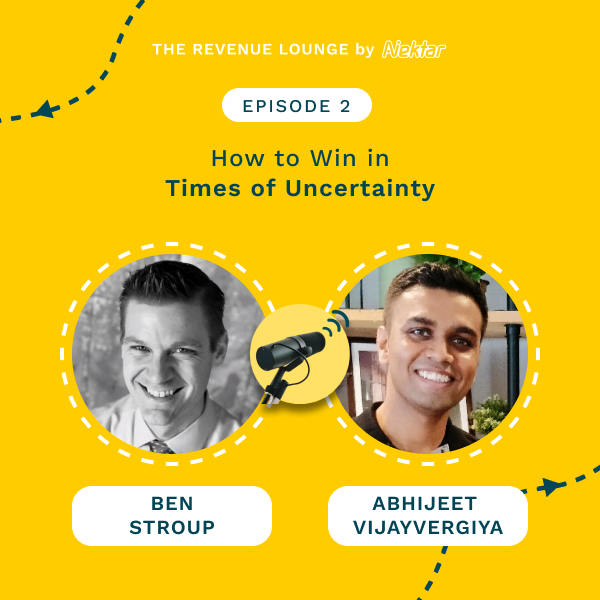
Ep #2: How to Win in Times of Uncertainty
Listen Now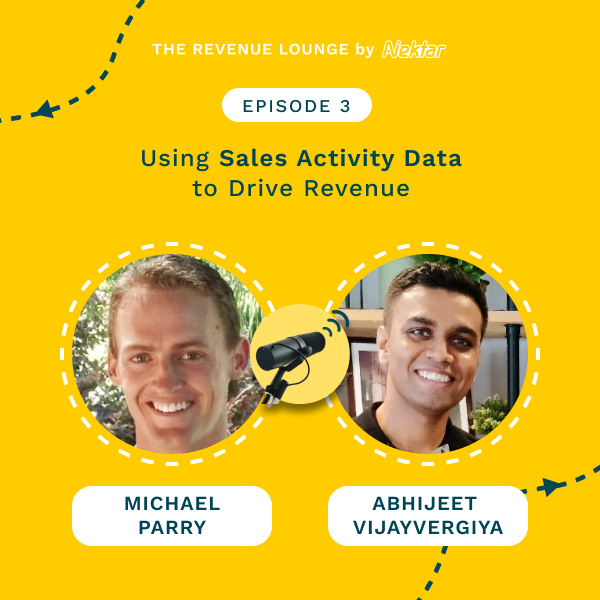
Ep #3: Using Activity Data to Drive Sales Productivity
Listen Now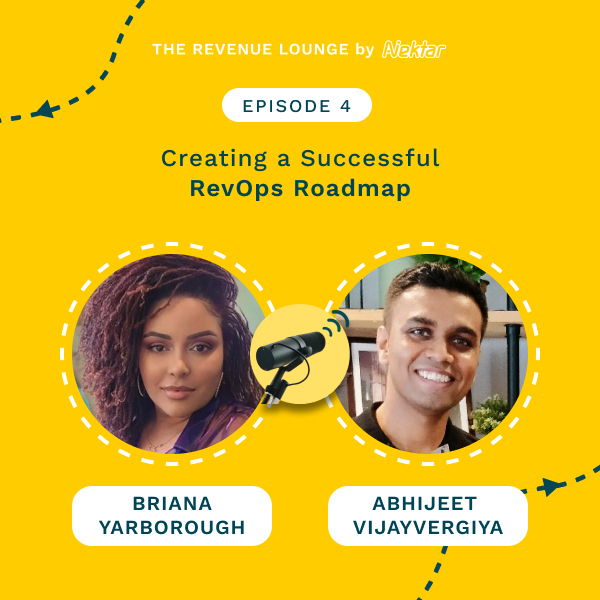
Ep #4: Creating a Successful RevOps Roadmap
Listen Now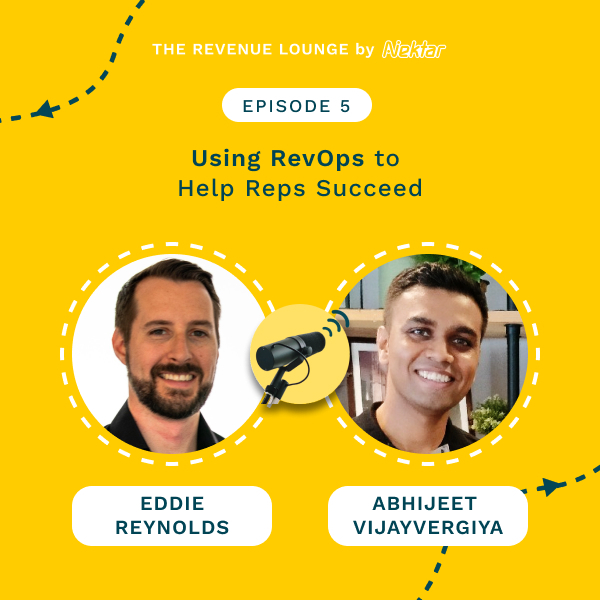
Ep #5: Using RevOps to Help Reps Succeed
Listen Now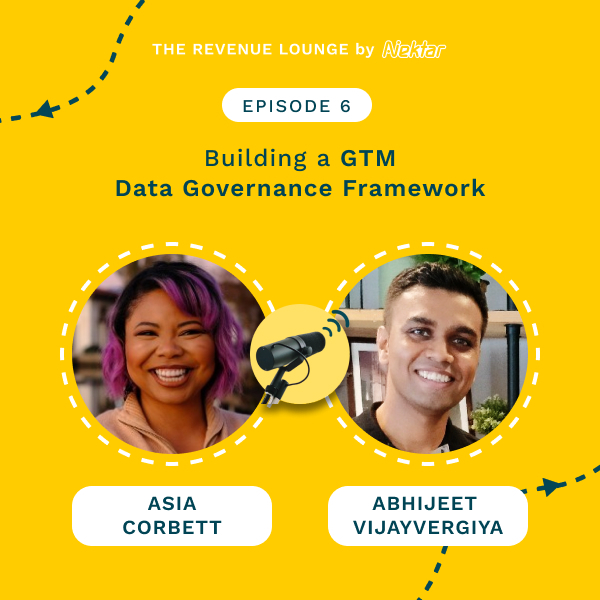
Ep #6: Building a GTM Data Governance Framework
Listen Now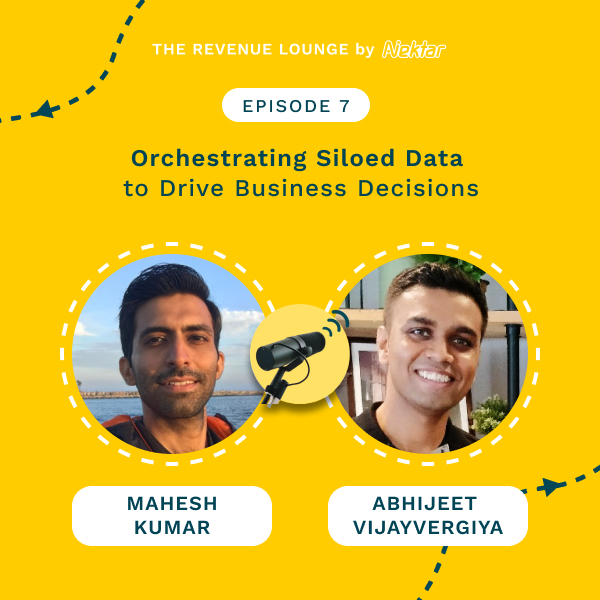
Ep #7: Orchestrating Siloed Data to Drive Business Decisions
Listen Now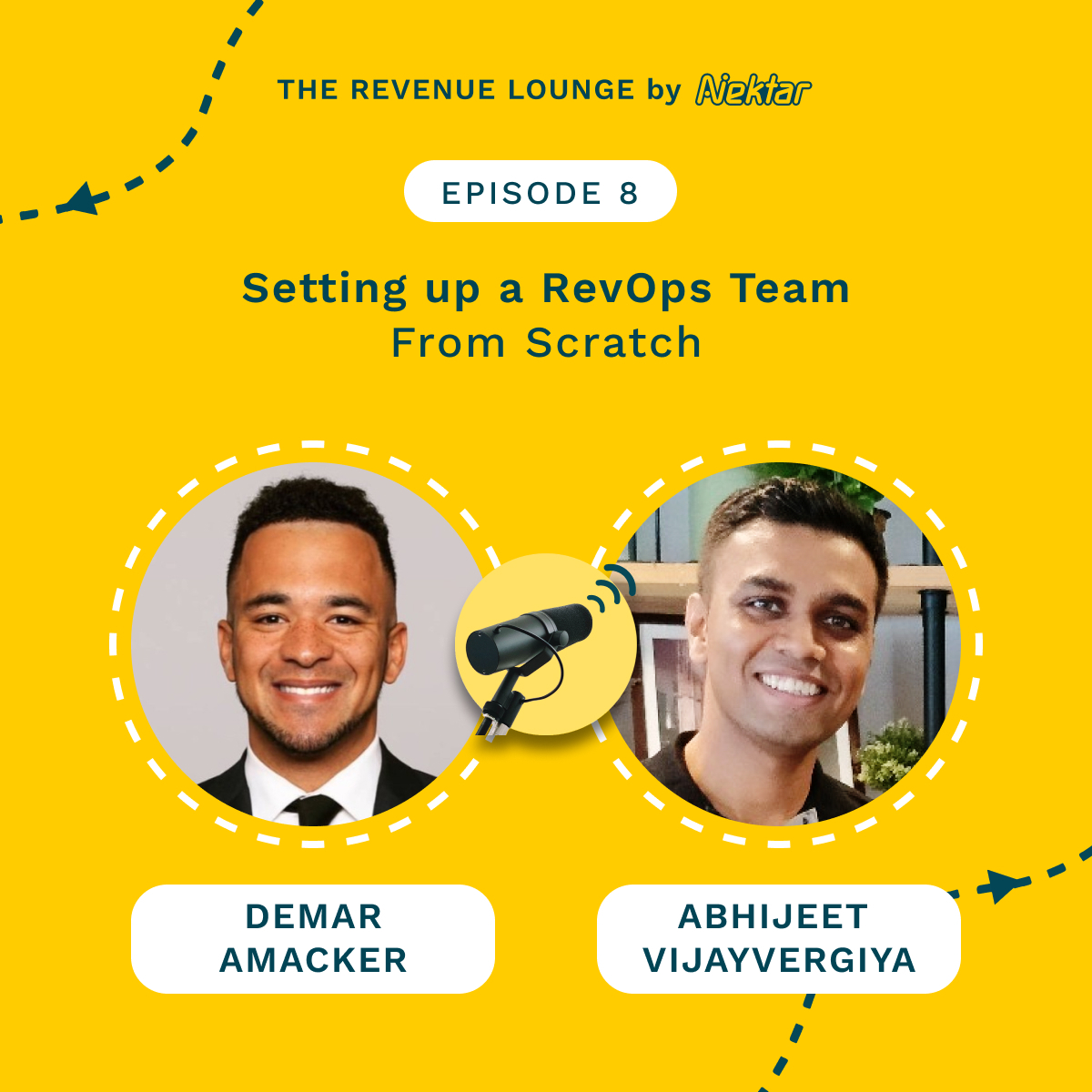
Ep #8: Setting Up a RevOps Team From Scratch
Listen Now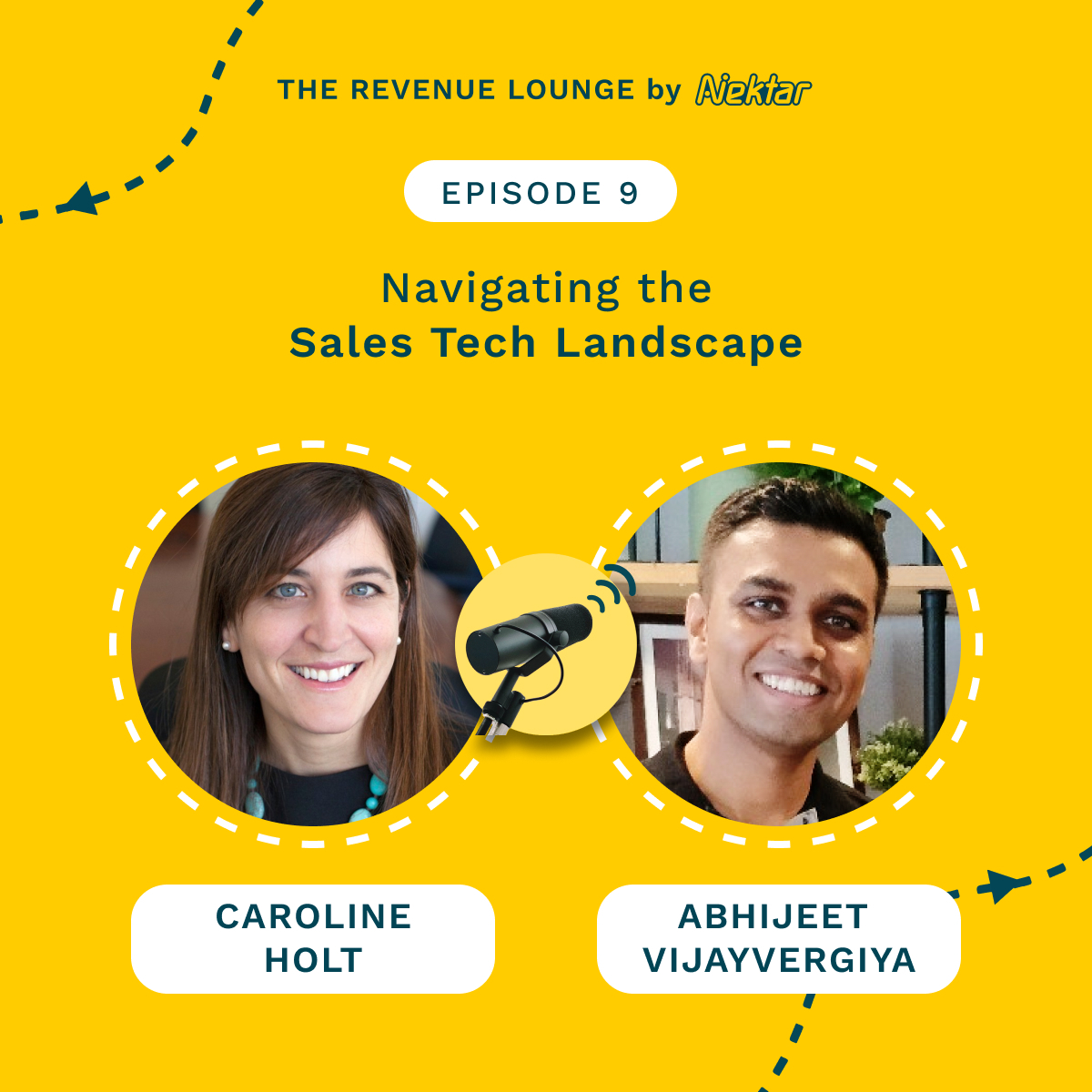
Ep #9: Navigating the Sales Tech Landscape
Listen Now